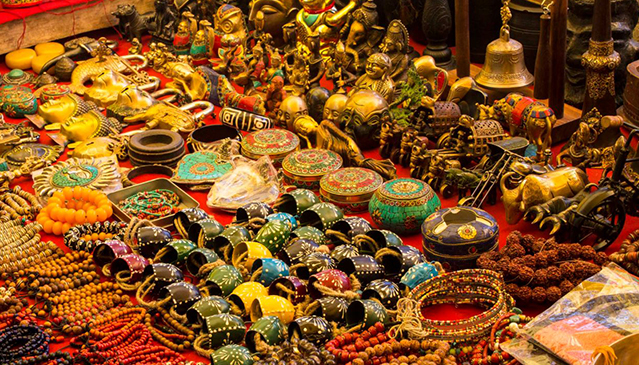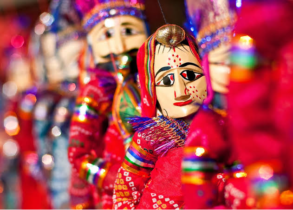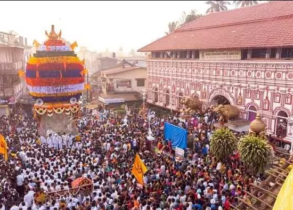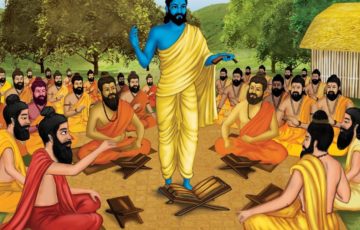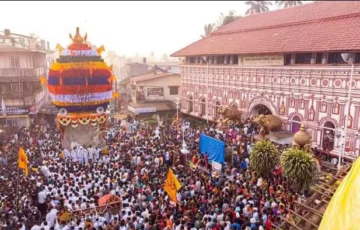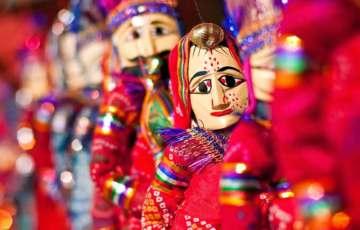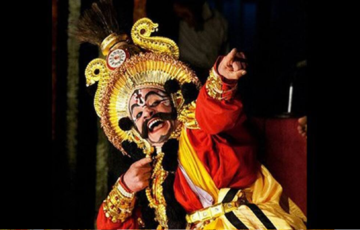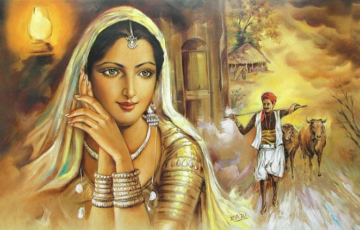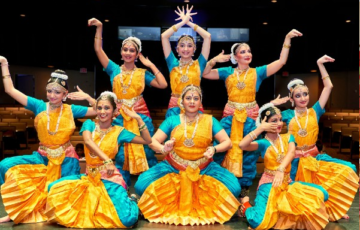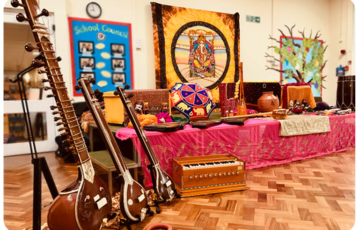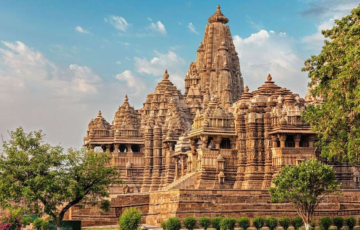INDIAN HANDICRAFT
- Handicrafts encompass a diverse array of manual or tool-driven activities, involving the meticulous crafting of both practical and decorative items by hand or with basic tools. This traditional form of craftsmanship extends across various creative and design pursuits, utilizing materials such as textiles, moldable and rigid substances, paper, plant fibers, and more. The collective terms used to describe handicrafts include artisanry, handicrafting, crafting, and handicraftsmanship.
- India stands as a rich repository of exquisitely crafted handicrafts, where ordinary objects undergo a transformative process, evolving into works of art through intricate designs that highlight the innovative spirit of Indian artisans. The roots of Indian handicrafts delve deep into history, spanning nearly 5000 years. The Indus Valley Civilization serves as a testament to this profound heritage, offering numerous examples that underscore the enduring legacy of craftsmanship in the Indian subcontinent.
Types of Handicrafts
India boasts a diverse range of handicrafts, each reflecting the unique skills and cultural heritage of different regions. Some of the major types of handicrafts in India include:
- Glassware
- Cloth Handicrafts including Tie and Dye and Embroidery Crafts
- Ivory Carving
- Terracotta Craft
- Silver Crafts
- Clay and Pottery Work
- Metal Crafts
- Leather Products
- Toy Making
- Stoneware
- Embroidery Craft
- Floor Designs
Glassware
- Glassware in India possesses a rich historical and cultural legacy, with its origins stretching back to ancient times. The Indian epic Mahabharata marks the first mention of glassmaking, even though tangible evidence of glass beads during the early Harappan Civilization is not immediately apparent. The Painted Grey Ware culture of the Ganges Valley, around 1000 BC, provides the earliest material evidence in the form of exquisite glass beads. Vedic texts, such as Satapatha Brahmana, use the terms “kanch” or “kaca” to signify glass.
- Archaeological discoveries shed light on the existence of a glass industry in Brahmapuri and Kolhapur in Maharashtra, operating between 2 BC-2 AD. This industry specialized in crafting glassware, particularly lenticular beads. Remarkably, ancient India’s glass industry even ventured into producing optical lenses, as references to spectacles are found in the Sanskrit text Vyasayogacharita.
- Southern India plays a significant role in this historical narrative, with archaeological findings at Maski, a Chalcolithic site in the Deccan. Additional sites such as Ahar (Rajasthan), Hastinapur, Ahichachhatra (Uttar Pradesh), as well as Eran and Ujjain (Madhya Pradesh), offer further evidence of India’s historical involvement with glass.
- During the medieval period, the Mughals played a pivotal role in patronizing the art of glassware, incorporating it into the decoration of monuments like the Sheesh Mahal. Notable glass items produced for the Mughals included hukkas, perfume boxes (ittardans), and engraved glasses.
- In contemporary India, the glass industry has diversified. Hyderabad is renowned for producing exquisite glass bangles known as “Churi ka jodas.” Firozabad is celebrated for crafting glass chandeliers and decorative pieces. Saharanpur in Uttar Pradesh has emerged as a center for manufacturing glass toys for children, known as “panchkora.” Patna in Bihar produces a distinctive form of decorative glass beads called “Tikuli,” although this craft has faced challenges due to industrialization. Efforts are underway to revive Tikuli art, with contemporary adaptations on glazed hardboards.
Textile
- The textile tradition of India is indeed diverse and deeply rooted in history, with two remarkable examples highlighted:
Jamdani:
- Jamdani, originating from Bengal and with its roots in Dhaka, Bangladesh, is celebrated as one of the finest muslin textiles. This hand-woven cotton fabric features intricate motifs skillfully woven into the fabric. Historically, the production of Jamdani was favored by imperial warrants of the Mughal emperors, and it remains a labor-intensive craft that showcases the expertise of handloom weavers. Traditional materials such as mill cotton thread, resham silk thread, muga silk, and tussar silk thread were employed in the weaving process.
Ikat (or Ikkat):
- Ikat, a dyeing technique used to pattern textiles, involves resist dyeing on yarns before the dyeing and weaving process. The resist is created by binding individual yarns or bundles of yarns with a tight wrapping in the desired pattern. After dyeing, the bindings may be altered to create new patterns, and this process can be repeated to achieve intricate, multicolored designs. Unlike other resist-dyeing techniques such as tie-dye and batik, where resist is applied to woven cloth, Ikat applies the resist to the yarns before weaving. This unique approach results in both faces of the fabric being patterned.
- The finest form of double Ikat, known as Patan Patola, is crafted in Patan, Gujarat, and is recognized as one of the most intricate forms of Ikat. Odisha’s style of Ikat, known as Bandha, features flowing designs. Andhra Pradesh’s version, referred to as chitki, is distinct, while Telia Rumal, a laborious double Ikat weave product, involves treating the yarn with oil, tying, and dyeing to create the desired patterns.
|
Techniques for Adorning Textile Surfaces
- Enhancing textile surfaces involves a variety of methods, encompassing printing, painting, tie and dye, and embroidery.
Textile Printing:
- The art of fabric printing employs various approaches, including direct printing with carved wooden blocks on bleached cotton or silk, resist printing that utilizes paste to imprint undyed sections of the cloth, and mordant-based printing.
Tie and Dye:
- Tie and dye stands out as a prevalent and traditional surface embellishment method in India. The intricate process of Bandhani or Bandhej involves tightly binding fabric at different points to create diverse patterns based on the tying technique. Various regions have distinct names for this technique, such as Leheriya Pattern (Bandhini) in Rajasthan, Bandhej in Gujarat, Chungidi in Tamil Nadu, and Laharia in Jaipur and Jodhpur, recognized for its ripple or wave-like patterns. Another form of tie and dye is ‘Ikat’ or ‘resist dyeing,’ where resist dyeing on yarn occurs before weaving. Telangana, Odisha, Gujarat, and Andhra Pradesh serve as significant centers for Ikat.
Ancient Techniques Still in Use:
- Kalamkari, an ancient art of hand-painting on fabrics using vegetable dyes, persists in practice in Andhra Pradesh. Batik Art, originating from Indonesia, involves saturating one end of the fabric with molten wax and cold wax dyeing, resulting in multicolored batik saris and dupattas. This technique is renowned in Madhya Pradesh and West Bengal.
Traditional Embroidery Techniques in Indian Textiles
- Kalamkari: Kalamkari, or qalamkari, is a form of hand-painted or block-printed cotton textile produced in regions of India and Iran. The name is derived from “qalam” (pen) and “kari” (craftsmanship), representing the art of drawing with a pen. Two distinct styles, the Srikalahasti style and the Machilipatnam style, both originating in Andhra Pradesh, showcase different approaches to kalamkari art. The Srikalahasti style involves freehand drawing with a pen, and all coloring is meticulously done by hand.
- Applique Work: Applique work involves decorating fabric with pieces of cloth, glass, metals, wood, or metal wires stitched onto it. Widely practiced in India, notable centers include Odisha, Punjab, Gujarat, and Rajasthan. In Odisha, applique work is integral to temple traditions, with Pipli near Bhubhaneshwar being a prominent production center. In Gujarat, applique work is referred to as “katab,” while Rajasthan is known for “ralli” quilts and applique gota and kinari work. Punjab combines applique with embroidery, creating intricate designs.
- Phulkari: Phulkari is an embroidery technique originating from the Punjab region, meaning “flower work.” Originally a term for embroidery, it later became associated with embroidered shawls and scarfs.
- Zardozi: Zardozi embroidery, once adorning the attire of Indian kings and royals, features intricate designs using gold and silver threads, pearls, and precious stones. Lucknow, Bhopal, Hyderabad, Delhi, Agra, Kashmir, Mumbai, Ajmer, and Chennai are significant centers for Zardozi embroidery.
- Aari: Kutch’s picturesque embroidery, known as aribharat, involves using an ari (hook) fed by silk thread from below. This technique gives a jewelry-like quality to the embroidery.
- Banjara Embroidery: Originating from the Lambada gypsy tribes of Andhra Pradesh, Banjara embroidery combines applique with mirrors and beadwork, featuring bright colors and white crisscross stitching.
- Chikankari: Lucknow’s Chikan work involves delicate white thread embroidery on various fabrics, originating from Nur Jehan’s patronage. Known for its intricate and subtle designs, Chikankari resembles shadow work.
- Crewel: Kashmir is renowned for crewel embroidery seen in woolen kurtas and rugs. This technique, similar to chain stitch, is executed from underneath the fabric using an awl for making holes.
- Gota Work: Jaipur’s intricate gold embroidery, known as gota-work, is a meticulous form of appliqué renowned for crafting intricate patterns using fine gold thread. Broad golden ribbons are carefully stitched along fabric edges, creating the illusion of gold zari work. This technique is frequently employed in the creation of women’s formal attire.
- Kantha: Kantha, a distinctive patchwork embroidery style prevalent in Bihar and West Bengal, involves repurposing remnants of white cotton saris as the foundation. Threads sourced from older materials are then used for embroidery, commonly featuring floral, animal, and bird motifs. Kantha is applied to both cotton and silk fabrics.
- Karchobi: Originating from Rajasthan, Karchobi is a raised zari metallic thread embroidery technique involving flat stitches on cotton padding. Widely employed for bridal and formal costumes, as well as for enhancing velvet coverings, tent hangings, curtains, and coverings of animal carts and temple chariots.
- Kashidakari: Kashidakari, or Kashmiri embroidery, evolved under the influence of Persian and Mughal rulers. Drawing inspiration from Kashmir’s scenic beauty, this embroidery style showcases flora-themed designs characterized by simple chain stitches. Notable motifs include the iconic Kashmiri tea pot.
- Kasuti: Representative of Karnataka’s Dharwar region, Kasuti is a delicate single-thread embroidery primarily seen on handloom saris. Executed in styles called gavanti and murgi, it features diverse motifs such as temples, peacocks, elephants, flowering trees, and geometric forms.
- Kathi (Rabari Art): A rural art originating from Gujarat, Kathi (Rabari Art) is associated with the nomadic Rabari tribes of Kutch. Combining chain stitch embroidery with appliqué work and mirror-like insertions, it often features motifs like camels, royal fans, elephants, scorpions, and women carrying water.
- Patti Ka Kaam: Exquisite embroidery work hailing from Aligarh in Uttar Pradesh.
- Pichwai: Colorful embroidered cloth hangings typical of Nathdwara in Rajasthan.
- Shamilami: A fusion of weaving and embroidery, once considered a symbol of high status in Manipur.
- Toda Embroidery: Originating in Tamil Nadu, Toda embroidery, known as “pugur,” meaning flower, is practiced by women of the Todu community in the Nilgiri Hills.
Ivory Craftsmanship in India
- The art of ivory carving in India has ancient origins, tracing back to the Vedic period, known as ‘danta,’ highlighting the use of elephant tusks as the primary source of ivory.
- Recent archaeological findings reveal that during the Harappan period, India actively participated in the export of ivory and ivory-crafted items, such as dice, to regions like Afghanistan, Turkmenistan, and parts of the Persian Gulf.
- Ivory craftsmanship flourishes throughout India, with each region showcasing its unique specialization. Highly skilled ivory artisans in Jaipur, Bengal, and Delhi are celebrated for their intricate engravings, crafting models like ‘ambari hathi’ or processional elephants, bullock carts, sandals, caskets, and palanquins.
Notable areas of expertise include:
- Odisha: Recognized for the tradition of presenting ivory-inlaid furniture to the Jagannath temple at Puri.
- Jodhpur: Acknowledged for the creation of detailed ivory bangles.
- Jaipur: Renowned for its jali work, applied to both home decor and small art objects.
- Kerala: Celebrated for its mastery in the art of painting on ivory.
Wooden Craftsmanship in India
Wood Carving:
- Wood carving is the artistic process of shaping and embellishing wooden objects, resulting in a diverse array of utilitarian and decorative handicraft items. Commonly utilized woods for this craft include teak, sal, oak, ebony, mango, and sheesham.
- Saharanpur in Uttar Pradesh enjoys global recognition for its wood carving, often being referred to as the “Shisham Wood Village” or the “Wood City” of India. Other notable centers for wood carving include Manipur, Bhopal, Nagpur, Chennai, Madurai, and Mysore. Kashmir stands out for its renowned walnut wood carving.
Wood Inlay/Marquetry:
- Wood inlay, or marquetry, involves embellishing the surface of wood by embedding pieces of materials like ivory (traditionally), bone, plastic, shell, or wood of various colors. Products showcasing inlay work range from doors, jewelry boxes, plates, and bowls to cigarette cases and figurines, especially those featuring elephants. Introduced to India from Persia in the 18th century,
- Mysore and Bengaluru in Karnataka are significant hubs for this craft. Scenes depicting royal Indian processions, landscapes, deities, and narratives from the Mahabharata and Ramayana often utilize shade effects in this craft.
Wood (Turning and Lacquerware):
- Wood turning involves using a lathe to shape rapidly rotating pieces of wood with a chisel, creating cylinders, spheres, or cones. The craft’s allure lies in painting these smooth wooden shapes, typically coated with colored lacquer. Lacquerware production has expanded to encompass jewelry, decorative items, household utilities, and educational articles like skipping rope handles, chess sets, pen holders, paperweights, and rubber stamp holders.
- Etikoppaka in Andhra Pradesh is celebrated for lacquerware, while Chennapatna toys, also recognized for lacquer, have been honored with the GI tag.
Clay and Pottery Work
- Pottery is frequently likened to the ‘lyric of handicrafts’ due to its universally captivating and irresistible nature.
- Clay craft stands as one of humankind’s earliest creations. The legacy of clay pottery in India extends over 10,000 years, and the unearthed clay artifacts from the Indus Valley Civilization sites highlight the remarkable skill and technology honed by Indian potters.
- Jhuker Pottery is associated with the residents of Harappan towns like Amri and Chanhudaro situated in Sind.
| Pottery Type | Origin | Features |
| Khurja Pottery | Khurja (Uttar Pradesh) | Colorful and robust, commonly used for household items. |
| Black Pottery | Azamgarh | Distinctive dark tint. |
| Glazed Tiles | Chunar and Chinhat | Utilizes special glazing techniques. |
| Blue Pottery | Jaipur | Crafted from Multani Mitti (Fuller’s Earth). |
| Kagzi Pottery | Alwar | Delicate, thin, and slightly brittle pottery. |
| Pokhran Pottery | Pokhran | Primarily employed for household items. |
| Dalgate Pottery | Jammu & Kashmir | Features special glaze. |
| Karigari Pottery | Tamil Nadu | Prominent in South Arcot with special crafting centers. |
| Surai | West Bengal | Commonly used for jugware. |
| Gopichandan | Saurashtra | Art objects crafted from clay. |
Metal Craft
- A diverse range of metal castings can be achieved using materials such as iron, copper, bell metal, and more. These crafts are distinguished by the application of ornamentation techniques like engraving, embossing, and damascening. Embossing, or repousse, involves creating raised designs in relief, while engraving entails cutting or scratching lines on metal.
- Some celebrated metal crafts:
- Marodi: Originating from Rajasthan, Marodi work involves etching designs on base metal and filling the gaps with resin.
- Badla Pots: Typical of the Marwar region in Rajasthan, these zinc pots come in round, semi-circular, or rectangular shapes, often equipped with ice chambers and taps.
- Nakashi: Moradabad is renowned for khudai or metal engraving work done in the nakashi style, producing fine and delicate works known as barik kam.
- Koftagiri: Also known as damascening, this technique involves inlaying a light metal onto a dark one. Predominantly practiced in Alwar and Jaipur, it is commonly applied to craft items like swords, daggers, and shields.
- Meenakari: Enamel work on gold, popularized by Maharaja Man Singh I and recognized in Delhi and Jaipur.
- Tarkashi: This charming technique involves laying fine brass or copper wire into carefully chiseled grooves in a metal or wooden surface.
- Bidri Work (Bidriware): Hailing from Bidar in Karnataka, Bidri work features silver inlay against dark metal backgrounds.
- Mohra: A unique metal craft of Himachal, Mohras are metal plaques representing deities, commonly found in Kullu and Chamba.
Bronze Crafts
- In ancient India, metals were predominantly utilized for utilitarian purposes, such as fashioning spears and arrows, rather than being exclusively dedicated to artistic pursuits. Nevertheless, metal casting played a pivotal role in craftsmanship for over 5000 years. One of the earliest instances of metal art is exemplified by the bronze work seen in the Dancing Girl statue from Mohenjo-daro, dating back to approximately 3500-3000 BC.
- The earliest application of non-ferrous metals by humans involved the combination of copper and tin to create bronze. The Matsya Purana provides the earliest literary evidence of various bronze casting methods, while subsequent texts, like the Rasaratnakara, delve into topics such as metal purity and zinc distillation.
- Uttar Pradesh stands out as a prominent region renowned for bronze craftsmanship, housing major centers in Etawah, Sitapur, Varanasi, and Moradabad. These centers specialize in crafting decorative items such as flower pots and images of gods and goddesses. Additionally, they are highly esteemed for producing ritualistic objects like tamrapatra, kanchantal, and panchpatra.
- Tamil Nadu represents another significant center, focusing on the creation of exquisite ancient statues reminiscent of art forms from the Pallava, Chola, Pandyan, and Nayaka periods.
- At present, vital centers for brass work across India include:
- Gaja Tandava: Featuring the portrayal of Shiva dancing in the Tandava pose, particularly prominent in Kerala.
- Rare Jain Imagery and Icons: Mirroring the historical significance of ancient Jain pilgrimage centers in Karnataka.
- Dokra Casting: Utilized for the creation of brass ornaments, notably practiced in Odisha and West Bengal.
- Pahaldar Lamps: Crafted from copper and brass, these lamps are available in various styles and shapes, with substantial production in Jaipur and parts of Uttar Pradesh.
- Pembarthi Craft: Involves crafting exquisite sheet metal (brass) art used to adorn chariots and temples, predominantly in Telangana.
Leather Artistry in India
- The origins of this craft are believed to date back to around 300 BCE. The most remarkable leather products in India are associated with footwear, celebrated for their traditional, genuine, individualistic, and vibrant designs. These footwear items are frequently adorned with embroidery, brocade, or decorative textiles.
- Maharashtra is renowned for producing the exceptionally comfortable and stylish Kolhapuri chappals. In Rajasthan, the Mojadi or Jutti holds particular popularity—a captivating footwear item where leather is embellished, punched, studded, and stitched into various enchanting designs. Jaipur and Jodhpur emerge as prominent centers for traditional footwear. Another distinctive product from Rajasthan is the Kupi, a bottle made from camel hide used to store oil or ‘attar’ (perfume), with Bikaner being a notable hub for this craft.
- In the Manoti art of Bikaner, artisans create articles like lamps and lampshades using camel hides, which are then colored, adorned with floral designs and figures, and plated with thin gold leaves.
Diverse Regional Footwear Heritage
| Regional Footwear | Primary Production Region | Details |
| Konglan Stitched Boots | West Bengal | Manufactured in the northern part of West Bengal, these boots are characterized by thick leather soles and high-layered sides made from either leather or thick cloth. |
| Paabu Stitched Boots | Jammu and Kashmir | Traditional knee-length boots known for their vibrant colors, originating from the Ladakh region. |
| Kolhapuri Chappal (GI) | Karnataka and Maharashtra | Handcrafted pure leather ethnic footwear, primarily crafted in the Kolhapur region of Maharashtra and some parts of Karnataka. |
| Katki Chappal | Odisha | Ethnic leather footwear. |
| Tilla Jutti (Traditional Footwear) | Punjab | Inspired by Indian Rajputana, this traditional footwear is typically crafted from leather and adorned with extensive embroidery using gold and silver thread. |
| Mojari (Leather Footwear) | Rajasthan | Traditionally crafted by artisans using tanned leather. |
| Multani Khussa | Rajasthan and Punjab | Made using vegetable-tanned leather, the Multani Khussa is embroidered with brass nails, mirrors, ceramic beads, and more. |
Stonework
- India’s tropical and geographical context, it is evident that stone masonry and craftsmanship hold a prominent place in the country’s artistic traditions.
- In ancient times, artisans needed advanced skills in carving and sculpting to create exquisite monuments. South Indian towns display some of the finest examples of stonework, utilizing various stones, including soft-brittle sandstone, patchy red stone, and hard granite.
- The challenge was to craft lifelike structures that captured natural postures exhibited by people. Evidence of these sculptures and architectural facades dates back to monuments from the Mauryan Period. Notable examples include the rock-cut caves of Ajanta and Ellora, the erotic sculptures of Khajuraho, and the Buddhist carvings of Sanchi and Bharhut. In hilly regions, the monolithic carving of rock-cut temples at Masrur in the Kangra district of Himachal Pradesh, dating back to the early 8th century AD, stands as a remarkable testament.
- During the Mughal period, there was a significant transition from stone to marble stonework. The focus shifted to inlay work with colorful stones on marble, known as Pietra Dura Work. While sandstone was extensively used, some of the grandest monuments, such as the Taj Mahal and Itmad-ud-Daulah’s tomb, were crafted from white marble. Rajasthan, renowned for producing the famed ‘Sang-e-Marmar’ or white Makrana marble, serves as a major center for marble procurement. Another noteworthy location is Jhansi in Uttar Pradesh, where articles are crafted from dark brown stone known as Sang-e-Rathak.
Floor Designs
- Floor designs captivate a diverse audience, transcending regional boundaries and making appearances in various states, especially during religious or auspicious family events.
- Crafted with a freehand approach, these designs begin with a central dot and evolve into concentric patterns featuring geometric shapes such as circles, squares, triangles, straight lines, and curves. This organic drawing method initiates at the center and expands with repeated patterns.
- Artisans often opt for natural materials and colors that neither stain the floor nor present challenges in erasure, emphasizing the impermanent nature of these designs. White tones may be achieved using dry chalk, lime powder, powdered marble, or a blend of rice powder and lime.
- Distinct styles emerge across regions. In Punjab and Uttar Pradesh, Chowk Purna designs incorporate squares, circles, and triangles as foundational motifs, commonly created during auspicious festivals. Rajasthan and Madhya Pradesh showcase Mandana, meaning decoration, encompassing shapes like squares, hexagons, triangles, and circles. Ground preparation involves cleaning with cow dung and finishing with crimson red. Gujarat introduces Santhias to adorn house entrances on significant occasions, while Maharashtra’s Rangoli integrates elegant shapes and motifs like lotus and swastika.
- In South India, Kolam designs connect an array of dots with thin lines drawn using powdered rice or crushed stone on wet ground. Common motifs include cosmological bodies like the Sun and the Moon. Larger Mandapa Kolams are exclusively drawn for marriage ceremonies, employing wet rice paste to add sanctity to the marriage hall. Graha Kolams sanctify spaces for daily worship in many households.
- The highly stylized Jhonti in Odisha and Aripana designs in West Bengal and Assam feature motifs like conch shells, fish, serpents, and flowers. These designs, drawn on the floor with chalk powder, are filled with colored powder or rice paste tinted with alta (sindoor) for red and turmeric for yellow, with the customary practice of placing a flower before each Aripana design.

